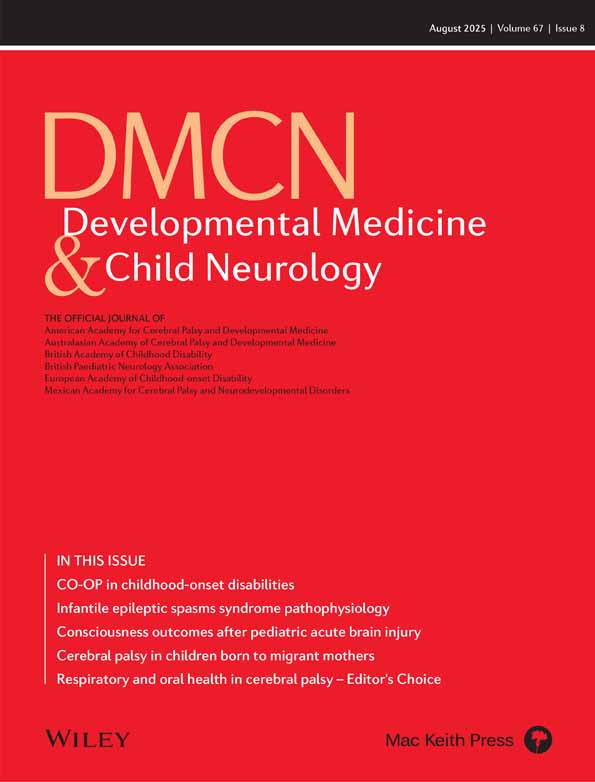EFFICACY OF TWO TREATMENT APPROACHES TO REDUCE TONGUE PROTRUSION OF CHILDREN WITH DOWN SYNDROME
Abstract
SUMMARY
Five children with Down syndrome aged between 21 and 31 months, all of whom demonstrated habitual tongue protrusion, were randomly assigned to receive either oral-motor treatment or behavior modification. Tongue posture of all three children who received oral-motor treatment improved. For two of these the improvement leveled off after treatment had ended, but the third continued to show improvement. One of the two children receiving behavior modification showed improved tongue posture during treatment and maintained the improvement, but for the second there were insufficient data points to draw firm conclusions. Both forms of treatment appear to be effective, but further study is needed before definite conclusions can be made.
RÉSUMÉ
Efficacité de deux approches thérapeutiques pour réuire la protrusion de la langue chez le mongolien
Cinq mongoliens âgés de 21 à 31 mois présentant tous une protrusion habituelle de la langue se sont vus assigner au hasard un traitement oro-moteur ou un traitement de modifications comportementales. La position de la langue chez les trois enfants ayant Mneiicie du traitement oro-moteur s'ameliora. Le bénéficé acquis disparut après la fin du traitement pour deux enfants mais l'amélioration persista dans le troisième cas. Un des deux enfants bénéficiant de modifications comportementales améliora la position de sa langue durant le traitement et maintint le bénéfice, mais les donnees sont insuffisantes pour tirer des conclusions nettes dans le second cas. Les deux formes de traitement semblent efficaces mais des études ulterieures sont nécessaires avant que des conclusions définitives puissent être tirées.
ZUSAMMENFASSUNG
Wirksamkeit zweier Behandlungsansätze zur Verminderung der Zungenprotrusion bei Kindern mit Down Syndrom
Fünf Kinder mit Down Syndrom im Alter zwischen 21 und 31 Monaten, die alle eine habituelle Zungenprotrusion aufwiesen, wurden zufallig einer oral-motorischen Behandlung oder einer Behandlung mit Behavior Modification zugewiesen. Die Zungenhaltung verbesserte sich bei alien drei Kindern, die eine oral-motorische Behandlung erhielten. Bei zwei dieser Kinder ließ die Besserung nach Beendigung der Behandlung wieder nach, bei dem dritten jedoch blieb sie bestehen. Eins der zwei Kinder, die eine Behavior Modification Therapie erhielten zeigte während der Behandlung eine bessere Zungenhaltung und diese Besserung hielt an, für das zweite lagen unzureichende Daten vor, um irgendwelche Rückschlüsse Ziehen zu können. Beide Behandlungsformen scheinen Erfolg zu haben, für eine endgültige Beurteilung sind jedoch noch weitere Studien erforderlich.
RESUMEN
Eficacia de dos tipos de tratamiento para reducir la protrusión de la lengua en niños con sindrome de Down
Cinco niños con síndrome de Down de 21 a 31 meses de edad mostrando todos la habitual protrusión lingual, fueron asignados al azar para recibir una tratamiento oral motor o una modificación de conducta. La postura de la lengua majoró en los tres niños que recibieron un tratamiento oral motor. En dos de ellos, la mejoria desapareció después de terminado el tratamiento, pero el tercero continúo mostrando majoría. Uno de los dos niños que recibian modificación de conducta mostró una mejoria en la postura lingual durante el tratamiento y mantuvo esta mejoria, pero en el segundo niflo no habian suficiantes datos para sacar conclusiones firmes. Parece que ambas formas de tratamiento son efectivas, pero se necesitan más estudios para que se puedan sacar conclusiones definidas.




